Posted by Elena del Valle on August 30, 2012
Information provided by Event Partner

The 10th Annual Hispanic Television Summit
Wednesday, October 3rd
The Marriott Marquis New York Hotel, Times Square
Discount pricing for HispanicMPR.com subscribers
$393 through September 14 (10% off regular price of $435)
$449 after September 14 (10% off regular price of $499)
Enter Promo Code: HTS1
The 10th Annual Hispanic Television Summit will be held Wednesday, October 3, 2012 at The New York Marriott Marquis Hotel. It is presented by Broadcasting & Cable and Multichannel News. This year’s award recipient is Telemundo network news anchor, José Díaz-Balart. Additionally, a new award will be introduced in acknowledgement of a company’s or organization’s tenacious commitment to continued service to the Latino viewer. This first-ever award will be presented to Comcast Cable, with a special address by Comcast executive, Marcien Jenckes.
The Hispanic Television Summit is the signature conference for executives involved in the business of television and digital video targeted to the US Hispanic and Latin American viewing audience.
To register, please visit http://hispanictvsummit.com/
Posted by Elena del Valle on August 27, 2012
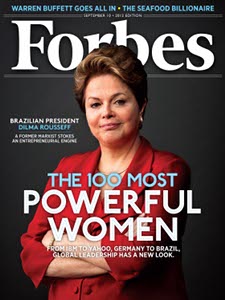
Forbes 100 Most Powerful Women cover
Photo: Forbes
For nine years Forbes has compiled a list of 100 Most Powerful Women around the world. German Angela Merkel was at the top followed by Hillary Clinton in this year’s recently released list. The cover is occupied by Dilma Rousseff, president, Brazil and number three on the list. The magazine dedicated pages 64 to 69 to her. Of the top ten women on the list six are from the United States and there is at least one Latina, Jennifer Lopez in the Celebrity category, among the 100 influential women from around the globe. She appears in the thirty eighth spot.
Some Latinas like Shakira and Sofia Vergara among the celebrities and several in other categories who United States audiences may recognize appear on the list but they are listed in the country where they reside. In the case of Shakira and Sofia Vergara that is Colombia. While 28 countries are represented 61 of the women reside in the United States.
Although there is no list of most powerful men there is a list of Most Powerful People due to be released later this year. A spokesperson declined to identify “how much time it takes to report for our lists.”
For this year’s list the publication selected the 100 most influential women from seven categories or power bases: billionaires, business, lifestyle (including entertainment and fashion), media, nonprofits/NGOs, politics and technology. Staff assigned the rank within each category, as well as overall rank on the list of 100, by applying three metrics: money, media presence and impact.
For the money metric, the staff took into account 2011 company revenue and market value if it was available for business, media and tech; for lifestyle salary, they relied on the Forbes 2012 Celebrity 100; for GDP, politics and net worth they looked at the Forbes 2012 World’s Billionaires list for those with 10-figure bank accounts; and women from nonprofits/NGOs were rated on dollars spent fulfilling the organization’s mission.
They took into consideration media component accounts for news hits (Factiva) and TV and radio appearances (Nexis) from the past 12 months, as well as number of followers on social media channels Facebook, Twitter and YouTube as of July 2012. They scored candidates on their impact including “the extent of their reach across industries, cultures and countries, the number of spheres of influence and people they affect and how actively they wield their power.”
The top names from the United States were: Hillary Clinton, Secretary of State, United States; Melinda Gates, co-chair, Bill & Melinda Gates Foundation; Jill Abramson, executive editor, New York Times Co.; Michelle Obama, first lady, United States; Janet Napolitano, secretary, Department of Homeland Security, United States; Sheryl Sandberg, COO, Facebook; Oprah Winfrey, entrepreneur; Indra Nooyi, chairman and CEO, PepsiCo; and Irene Rosenfeld, chairman and CEO, Kraft.
Posted by Elena del Valle on August 24, 2012
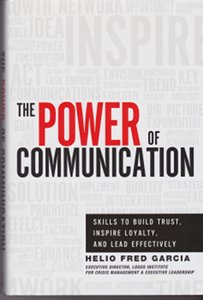
The Power of Communication book cover
Photo Helio Fred Garcia: Newman Communications
To be successful leaders must posses outstanding communication skills. That is the firm belief of Helio Fred Garcia, executive director, Logos Institute for Crisis Management and Executive Leadership. To master the skill of effective communication a leader must reach his or her audience where they are, he says.
In The Power of Communication: Skills to Build Trust, Inspire Loyalty, and Lead Effectively (FT Press, $26), published this year, he explains his thinking. He relies in part for his theories on Warfighting, the Marine Corps strategy doctrine military manual.
Communication has power that must be harnessed to keep it from backfiring, he says at the beginning of the book. At the same time, he believes that many of the principles necessary to lead armed forces are applicable to the discipline of public communication.
His goal in writing the book was to convert the Warfighting ideas into guidelines leaders can rely on for effective communication; share best practices lessons he has learned over his extensive years as a leadership consultant; and outline prominent case studies of communication failures and successes. Among the failures he cites Tony Hayward’s ineffectual handling of the 2010 BP Gulf of Mexico oil rig disaster and spill. He closes, in Chapter 10, with Nine Principles of Effective Leadership Communication.
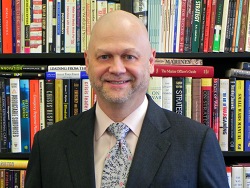
Helio Fred Garcia, author, The Power of Communication
“Age by itself is not necessarily an issue, but generational temperament is. One of the core principles (Principle No. 2) is that if we are to move people, we need to meet them where they are. That includes knowing what they care about, knowing how they prefer to be engaged, and even knowing what their capacity is for engagement,” Garcia said by email in response to a question about the possible role of age or generation on the principles he proposes.
“One of the key drivers of engagement is attention span, and we’re finding that generations that have grown up with technology and television tend to have a shorter attention span than prior generations. So leaders need to adapt to be able to reach them. The generation that is growing up with social media is a multi-tasking generation. So leaders have a particular challenge engaging them. For example, in the book I point to research showing that there’s no such thing as multi-tasking. There’s only serial micro-tasking. But two tasks aren’t done simultaneously: when someone is doing one thing, he or she is not doing the other thing. But folks toggle in and out of each activity very quickly. That’s why distracted driving is such a problem. And also why leaders need to adapt their engagement strategy to deal with those who would otherwise be inclined to be easily distracted.”
In response to a question about the applicability of the concepts in his book to diverse audiences he responded: “Per the prior question, the key to moving people is meeting them where they are. I do a lot of work with religious groups, with students and clients in other cultures, in other countries, and and in other languages. The principles don’t change, but what is necessary to connect given cultural, linguistic, emotional, or spiritual concerns does.
I have taught these principles on five continents and in dozens of countries, and I have found that the principles work. But how they are executed is culturally varied. When I work with religious leaders (wherever I may be) I focus on authenticity and living our values. When I work with corporate leaders I focus on what works. When I work with academics I focus on what research shows.
But even within these groups there are further cultural issues. For example, when I’m teaching government leaders in China I don’t prescribe. I don’t say ‘Here’s what you should do if you want to accomplish X…’ Rather, I say, ‘Here’s what we know works in the United States. It would be inappropriate for me to presume that it works here, but if you find it useful I would be very gratified…’ That usually has people smiling and nodding their heads.
I find that audiences whose first language is not English have embraced the book. For example, last week I heard from students in an MBA program in Santiago, Chile, who are reading the book. They were assigned to do a class presentation on it, and they reached out to me for materials. Is sent them some slides, and a video introduction I recorded in Spanish. And I’ll be speaking about the book next month in Lima at the International Public Relations Association’s Latin American Congress and Global Conference. I will be doing introductions in both Spanish and Portuguese.”
The 295-page hardcover book is divided into ten chapters and three main parts: Leadership and Communication: Connecting with Audiences; Strategy and Communication: Planning and Execution (one chapter long); and Building Skills: Getting Good at Communicating Well.
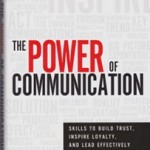
Click to buy Power of Communication
Comments:
Filed Under: Books
Posted by Elena del Valle on August 20, 2012
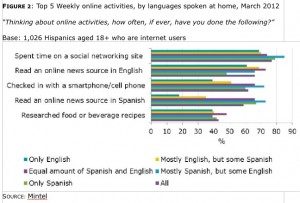
Hispanics Top 5 weekly online activities – click to enlarge
Graphic: Mintel
Hispanics spend an average of $150 per month on entertainment products and activities; and Latino families who earn between $50,000 and $74,900 a year are more likely to spend less than $100 per month on entertainment, according to a Mintel survey of adults conducted in March 2012. In general, the results of the survey reveal that that market segment is being frugal and thrifty in its entertainment spending. For many Hispanics cost plays a major role in their decisions about entertainment, according to the survey.
“Due to financial restraints, Hispanics are enjoying more in-home activities rather than spending their discretionary funds on out-of-home paid events,” said Adam Jacobson, multicultural analyst, Mintel. “Watching a movie on TV or reading a book or magazine is taking a front seat to more financially-driven experiences, such as dining out or going to live sporting events.”
A little more than one third (36 percent) of Latino respondents to the Mintel survey indicated they watch a movie on TV more than three times per week. One third of respondents said they like to read a book or magazine in Spanish; 40 percent of Hispanics said they like eating out one to three times per month; 34 percent said they attend a sporting event, and 30 percent said they planed to attend a street festival in the next three months.
For Latinos going out dining and the movies were popular entertainment options. More than half (53 percent) of respondents said they had seen a feature film in a theater at least once in the last year and 42 percent said they planned to go to the movies in the following three months.
Mintel researchers concluded that movie theaters might benefit from targeting Latino movie goers with concession items that appeal to Hispanics or family discount programs since as a group Hispanics tend to have larger families than non-Hispanics.
Another form of in home entertainment was online surfing. Many (77 percent) survey respondents said they connect with friends on social networking sites such as Facebook or Myspace. More than one third (36 percent) of Hispanic adults who took the survey said they visit their social networking websites thrice a day or more often using mobile devices. More than half (65 percent) of Latino survey takers who spent time online said they have a smartphone, and 31 percent said they have an iPad or tablet.
Although language preference didn’t seem to impact the amount of money respondents said they spent on entertainment, the percent of monies available varied by gender. Hispanic women said they were spending 40 percent less on entertainment than Hispanic men, regardless of their household income. Volunteerism was not popular among survey respondents regardless of their income level.
Information about the report, Hispanics and Entertainment US June 2012, was released this month. The survey was conducted among 1,026 adults online and respondents had the option to take it in English or Spanish. The complete 124-page report costs $3,995.
Posted by Elena del Valle on August 17, 2012
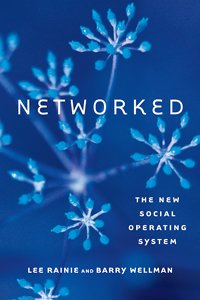
Networked book cover
Photo:The MIT Press
Lee Rainie, director, Pew Research Center Internet & American Life Project and Barry Wellman, S.D. Clark Professor of Sociology, University of Toronto believe digital communications via social media and smart phones, contrary to what others fear, are expanding learning opportunities, problem solving, decision making and personal relationships.
In Networked The New Social Operating System (The MIT Press, $29.95), published this year, they discuss the triple revolution they are convinced is transforming society in North America, sometimes for the better. The revolution the describe involves social networking, the internet and mobile digital devices.
At the beginning of the book, they illustrate what they see as the power of the revolution with the case of a couple who suffered from serious medical issues and thanks to their network of friends and acquaintances who knew them from professional and personal relationships asked for and received emotional and financial support. The authors believe people are now functioning within “networked individualism” that connects them to others in their circle of contacts in a novel way made possible by the triple revolution.
The 358-page hardcover book is divided into three sections: The Triple Revolution, How Networked Individualism Works, and How to Operate in a Networked World, Now and in the Future; and eleven chapters. In the final chapter, they discuss the future of networked individualism and their belief that social networks will play greater roles in people’s activities as well as the four areas they anticipate will be the source for issues relating to networked individualism in the future: internet, legislative, norms of social behavior within the network and technological commerce and related issues such as devices and apps.
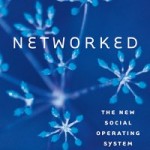
Click to buy Networked
Comments:
Filed Under: Books
Posted by Elena del Valle on August 13, 2012
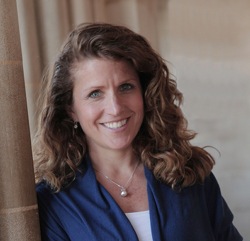
Camille Preston, Ph.D., PCC, founder and CEO, AIM Leadership
Photo: PR by the Book
A podcast interview with Camille Preston, Ph.D., PCC, founder and CEO, AIM Leadership is available in the Podcast Section of Hispanic Marketing & Public Relations, HispanicMPR.com. During the podcast, she discusses rewiring for results with Elena del Valle, host of the HispanicMPR.com podcast.
As a psychologist, executive coach, writer, facilitator and public speaker, Camille strives to guide companies and individuals to reach new heights of leadership, performance, efficiency, happiness and fulfillment at the organizational development company she founded.
To listen to the interview, scroll down until you see “Podcast” on the right hand side, then select “HMPR Camille Preston, Ph.D.” click on the play button below or download the MP3 file to your iPod or MP3 player to listen on the go, in your car or at home. To download it, click on the arrow of the recording you wish to copy and save it to disk. The podcast will remain listed in the August 2012 section of the podcast archive.
Posted by Elena del Valle on August 9, 2012
Information provided by Event Partner
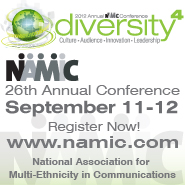
26th Annual NAMIC Conference
September 11-12, 2012
Hilton New York
www.namic.com
The media and cable telecommunications industry is ever changing. New technologies are enabling content to be available anywhere, anytime, and across multiple platforms. Driving this is the even more rapid pace of innovation. The customer base is also shifting, becoming more diverse, more global and more informed. All of this demands that industry professionals be culturally responsive, cater to new audiences and equip themselves with new leadership competencies. NAMIC’s 26th Annual Conference, Diversity to the Fourth Power or Diversity4 is focused on honing the skills of those professionals as they lead and innovate at the speed of change. Hear from thought leaders and trendsetters, and network with individuals from all industry sectors as NAMIC explores how diversity and inclusion are essential fuel for powering the future of the cable telecommunications industry.
Posted by Elena del Valle on August 8, 2012
An Audience Worth Reaching
By Nhora Barrera, president, TMNcorp
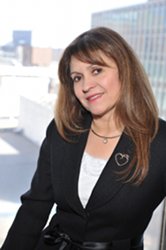
Nhora Barrera, president and CEO, TMNcorp
Photo: TMNcorp
There’s no question that America’s population is getting older, and it’s happening fast. Nearly 11,000 Americans turn 65 everyday 1. This aging population, however, isn’t homogenous. It is a demographic that reflects the nation’s growing diversity and challenges us to rethink how we reach them with information that will benefit their quality of life and health.
Hispanics seniors are a perfect example of this challenge. In 2008, there were 2.8 million Hispanics over 65 in America. But in just seven years, the group is predicted to be America’s largest elderly ethnic group.2 This number will only increase as the number of Hispanic-Americans continues to grow.
Read the complete article at Hispanic Seniors: An Audience Worth Reaching
Posted by Elena del Valle on August 6, 2012
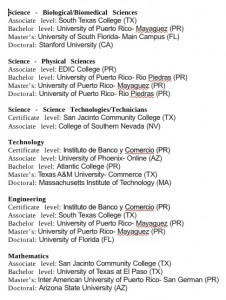
Top institutions awarding certificates/degrees to Latinos in STEM 2009 to 2010 by academic level – click to enlarge
Latinos earned only few (8 percent) certificates and degrees in Science, Technology, Engineering, and Mathematics (STEM) mostly from 25 institutions of higher learning, according to a recent Excelencia in Education report released last week. Excelencia, a nonprofit organization, strives to accelerate higher education success for Latino students.
“This analysis is straightforward: we know where Latinos are earning their degrees in STEM and we know what some of these institutions are doing, with intentionality, to improve Latino success in STEM fields,” said Deborah Santiago, author of the report and co-founder, Excelencia in Education. “What we need to determine now is whether more institutions and more employers will seize the opportunity to educate and employ more Latinos in professional STEM fields.”
In 2011, Latinos in the STEM workforce were more likely to be in lower paying service occupations such as electrical, electronics, and electromechanical assemblers, telecommunications line installers and repairers, and aircraft mechanics and service technicians rather than better paid professional occupations such architectural and engineering managers and computer and information systems managers.
Since the average age of Hispanics is lower than that of the general population and there is a high number of Latinos entering the workforce the findings are significant. The Executive Summary of the report indicates: “Given the relative youth of the Latino population relative to the aging of the u.s. population overall, supporting the increased growth of Latinos with postsecondary credentials in sTeM is critical to meeting the projected workforce needs of the nation by 2020.”
In 2009 to 2010, the top 25 institutions awarding undergraduate degrees or certificates to Latinos in STEM were in Texas, Florida, California, Arizona, Illinois, New Mexico and Puerto Rico. That same year, 60 percent of degrees conferred to Latinos in the science and related files were bachelor degrees, making those students most likely to enter service occupations in their chosen fields.
The 37-page report, Finding Your Workforce: The Top 25 Institutions Graduating Latinos in Science, Technology, Engineering, and Mathematics (STEM) by Academic Level (2009-10), was authored by Santiago, vice president for policy and research, and Megan Soliz, research assistant, Excelencia.
Posted by Elena del Valle on August 3, 2012
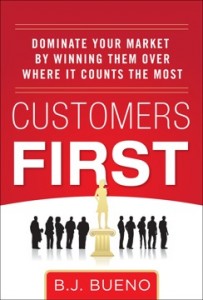
Customers First book cover
Photos: Newman Communications
What drives your customers? How do you create a brand that attracts loyal, profitable customers to your business? The correct answers to these questions could ensure the success of a company.
Bolivar J. “BJ” Bueno, founder and managing partner, The Cult Branding Company believes that most businesses struggle because they are not clear on the identity of their target customer; that they can’t rely on market research and focus groups for the answers because 90 percent of consumer behavior is unconscious; and that customers today are empowered, skeptical and educated consumers.
In Customers First: Dominate Your Market by Winning Them Over Where It Counts the Most (McGraw-Hill Professional, $26), his newly published 218-page hardcover book, he examines the strategic competitive advantage he believes comes from a complete, comprehensive understanding of a brand’s best customers. The book is divided into twelve chapters and four main parts, Introduction: Things Have Changed; Modeling Defined; Building Your Brand Model; and Deploying Your Model.

Bolivar J. Bueno, author, Customers First
Bueno says in the first chapter that there is no longer business as usual and that newcomers have to create a new normal. Customer awareness and loyalty, he explains in the next chapter, is what creates and expands a brand. Developing a great Brand Model, he says later in the book, requires time and adherence to that model. The author believes that effective predictions of consumer behavior helps make companies and their products or services dominant in the market.
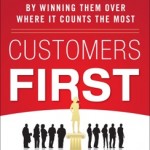
Click to buy Customers First
Comments:
Filed Under: Books
























